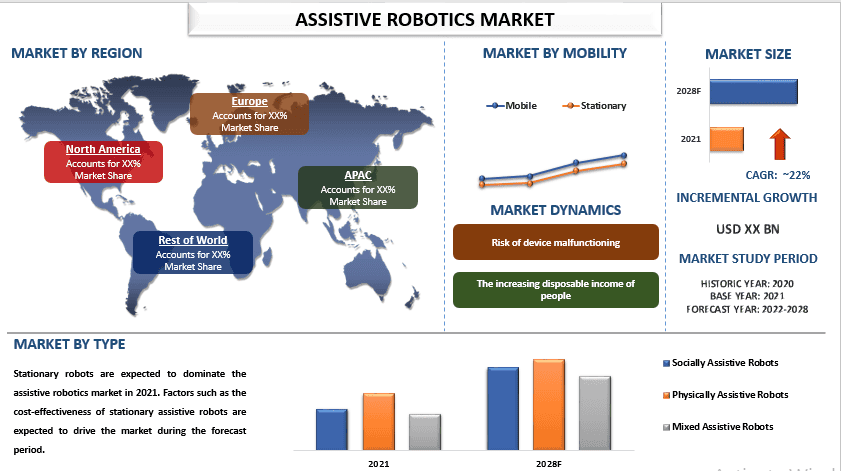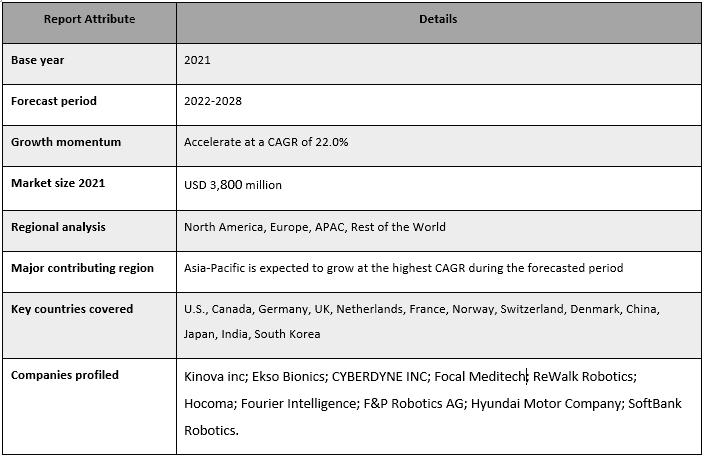Emphasis on Mobility (Mobile and Stationery); Type (Socially Assistive Robots, Physically Assistive Robots, and Mixed Assistive Robots); Application (Elderly Assistance, Surgery Assistance, Handicap Assistance, Defense, Industrial, Companionship, and Others); Region/Country.

The Assistive Robotics Market was valued at USD 3,800 million in 2021 and is expected to grow at a CAGR of 22.0% from 2022-2028. The assistive robotics market is being driven by a variety of factors, including an aging population in many countries, an increasing prevalence of disabilities, and advancements in robotics technology. As the demand for personalized and efficient healthcare solutions rises, assistive robotics are being developed to improve the quality of life for individuals with disabilities or age-related mobility impairments. Additionally, the growing trend of home healthcare and a focus on independent living has led to the development of assistive robots that can help with daily tasks, such as cleaning and meal preparation. The increasing adoption of robotics in healthcare and the ongoing advancements and investments in artificial intelligence and machine learning are also contributing to the growth of the assistive robotics market.
Some of the major players operating in the market include Kinova inc; Ekso Bionics; CYBERDYNE INC; Focal Meditech; ReWalk Robotics; Hocoma; Fourier Intelligence; F&P Robotics AG; Hyundai Motor Company; SoftBank Robotics. Several M&As along with partnerships have been undertaken by these players to facilitate customers with hi-tech and innovative products/technologies.
Insights Presented in the Report
“Amongst mobility, the stationary segment held a dominating share of the market in 2021”
On the basis of mobility, the market is segmented into mobile and stationery. The stationary segment is expected to achieve the largest market share and is expected to maintain similar growth during the forecast period. The growth of the segment is mainly attributed to the growth of stationary surgical robots. Surgical robotics are becoming increasingly in demand due to their ability to provide surgeons with greater precision and control during surgical procedures. Robotic arms can be programmed to make extremely precise movements, which can reduce the risk of human error and improve patient outcomes.
“Amongst type, the physically assistive robots held the majority share of the market in 2021”
Based on type, the market is segmented into socially assistive robots, physically assistive robots, and mixed assistive robots. Physically assistive robots are being developed and used to assist older adults and individuals with disabilities or injuries. With an aging population and an increasing number of individuals living with disabilities, there is a growing need for robots that can help with activities of daily living, mobility, and rehabilitation. Additionally, physically assistive robots can provide benefits such as increased independence, reduced healthcare costs, and improved overall quality of life for individuals and their caregivers.
“Asia Pacific anticipated to grow at the highest CAGR during the forecast period i.e., 2022-2028”
The Asia Pacific region is expected to be the fastest-growing region of the assistive robotics market. The region’s rapid growth is primarily driven by the increasing aging population, rising demand for independent living, and advancements in robotics technology. Countries like Japan, China, and South Korea are investing heavily in the development of assistive robotics to support their aging populations. Additionally, the region’s fast-growing economies are driving demand for automation in various industries, including healthcare and manufacturing, which is further fueling the growth of the assistive robotics market. Furthermore, the increasing adoption of assistive technologies by individuals with disabilities is also contributing to the market’s growth in the region. With these growth drivers in place, the Asia Pacific region is expected to continue its dominance in the global assistive robotics market in the coming years.
Assistive Robotics Market Report Coverage

Reasons to buy this report:
Customization Options:
The global Assistive Robotics Market can further be customized as per the requirement or any other market segment. Besides this, UMI understands that you may have your own business needs, hence feel free to connect with us to get a report that completely suits your requirements.
1. Market Introduction
2. Research Methodology Or Assumption
3. Market Synopsis
4. Executive Summary
5. Global Assistive Robotics Market Covid-19 Impact
6. Global Assistive Robotics Market Revenue, 2020-2028f
7. Market Insights By Mobility
8. Market Insights By Type
9. Market Insights By Application
10. Market Insights By Region
11. Assistive Robotics Market Dynamics
12. Assistive Robotics Market Opportunities
13. Assistive Robotics Market Trends
14. Demand And Supply-side Analysis
15. Value Chain Analysis
16. Pricing Analysis
17. Strategic Insights
18. Competitive Scenario
19. Company Profiled
20. Disclaimer
Research Methodology for the Assistive Robotics Market Analysis (2022-2028)
Analyzing the historical market, estimating the current market, and forecasting the future market of the global Assistive Robotics Market were the three major steps undertaken to create and analyze the adoption of Assistive Robotics in major regions globally. Exhaustive secondary research was conducted to collect the historical market numbers and estimate the current market size. Secondly, to validate these insights, numerous findings and assumptions were taken into consideration. Moreover, exhaustive primary interviews were also conducted, with industry experts across the value chain of the global Assistive Robotics Market. Post assumption and validation of market numbers through primary interviews, we employed a top-down/bottom-up approach to forecasting the complete market size. Thereafter, market breakdown and data triangulation methods were adopted to estimate and analyze the market size of segments and sub-segments of the industry pertains to. Detailed methodology is explained below:
Analysis of Historical Market Size
Step 1: In-Depth Study of Secondary Sources:
Detail secondary study was conducted to obtain the historical market size of the Assistive Robotics Market through company internal sources such as annual reports & financial statements, performance presentations, press releases, etc., and external sources including journals, news & articles, government publications, competitor publications, sector reports, third-party database, and other credible publications.
Step 2: Market Segmentation:
After obtaining the historical market size of the assistive robotics market, we conducted a detailed secondary analysis to gather historical market insights and share for different segments & sub-segments for major regions. Major segments are included in the report as mobility, type, and application. Further country-level analyses were conducted to evaluate the overall adoption of testing models in that region.
Step 3: Factor Analysis:
After acquiring the historical market size of different segments and sub-segments, we conducted a detailed factor analysis to estimate the current market size of the assistive robotics market. Further, we conducted factor analysis using dependent and independent variables such as product, technology, and end-users of the Assistive Robotics Market. A thorough analysis was conducted of demand and supply-side scenarios considering top partnerships, mergers and acquisitions, business expansion, and product launches in the Assistive Robotics Market sector across the globe.
Current Market Size Estimate & Forecast
Current Market Sizing: Based on actionable insights from the above 3 steps, we arrived at the current market size, key players in the global assistive robotics market, and market shares of the segments. All the required percentage shares split, and market breakdowns were determined using the above-mentioned secondary approach and were verified through primary interviews.
Estimation & Forecasting: For market estimation and forecast, weights were assigned to different factors including drivers & trends, restraints, and opportunities available for the stakeholders. After analyzing these factors, relevant forecasting techniques i.e., the top-down/bottom-up approach were applied to arrive at the market forecast for 2028 for different segments and sub-segments across the major markets globally. The research methodology adopted to estimate the market size encompasses:
Market Size and Share Validation
Primary Research: In-depth interviews were conducted with the Key Opinion Leaders (KOLs) including Top Level Executives (CXO/VPs, Sales Head, Marketing Head, Operational Head, Regional Head, Country Head, etc.) across major regions. Primary research findings were then summarized, and statistical analysis was performed to prove the stated hypothesis. Inputs from primary research were consolidated with secondary findings, hence turning information into actionable insights.
Split of Primary Participants in Different Regions
Market Engineering
The data triangulation technique was employed to complete the overall market estimation and to arrive at precise statistical numbers for each segment and sub-segment of the global Assistive Robotics Market. data was split into several segments & sub-segments post studying various parameters and trends in the areas of the product, technology, and end-users in the global Assistive Robotics Market.
The main Objective of the Global Assistive Robotics Market Study
The current & future market trends of the global assistive robotics market were pinpointed in the study. Investors can gain strategic insights to base their discretion for investments on the qualitative and quantitative analysis performed in the study. Current and future market trends determined the overall attractiveness of the market at a regional level, providing a platform for the industrial participant to exploit the untapped market to benefit from a first-mover advantage. Other quantitative goals of the studies include:

Customers who bought this item also bought